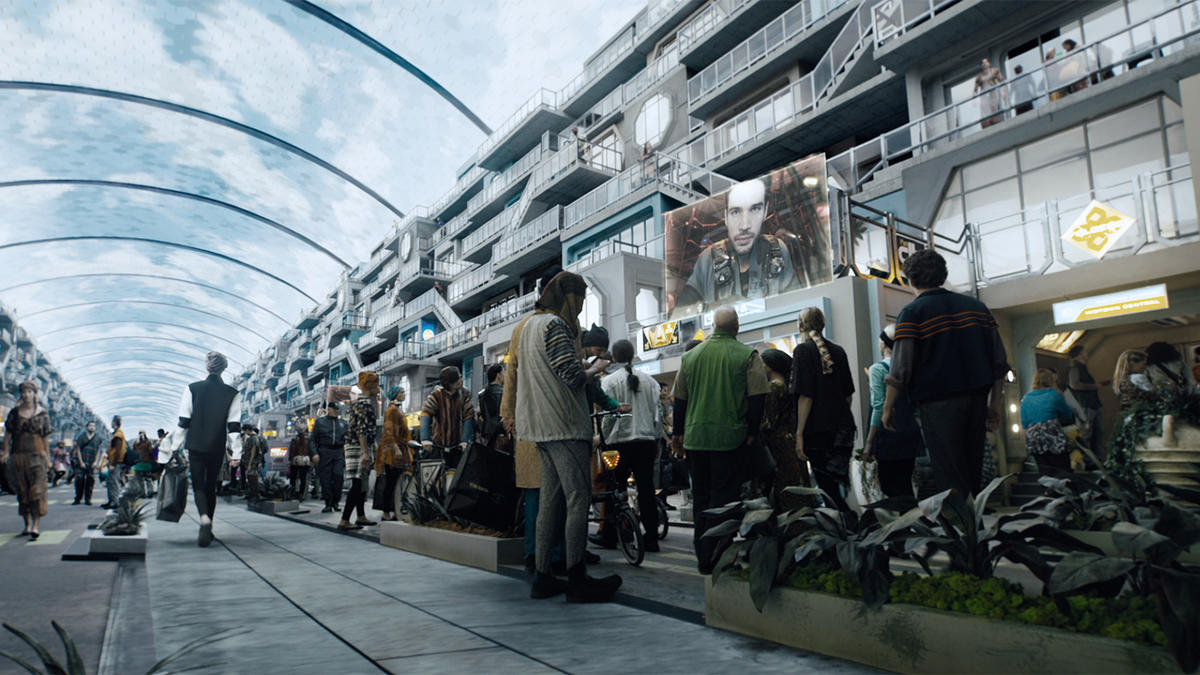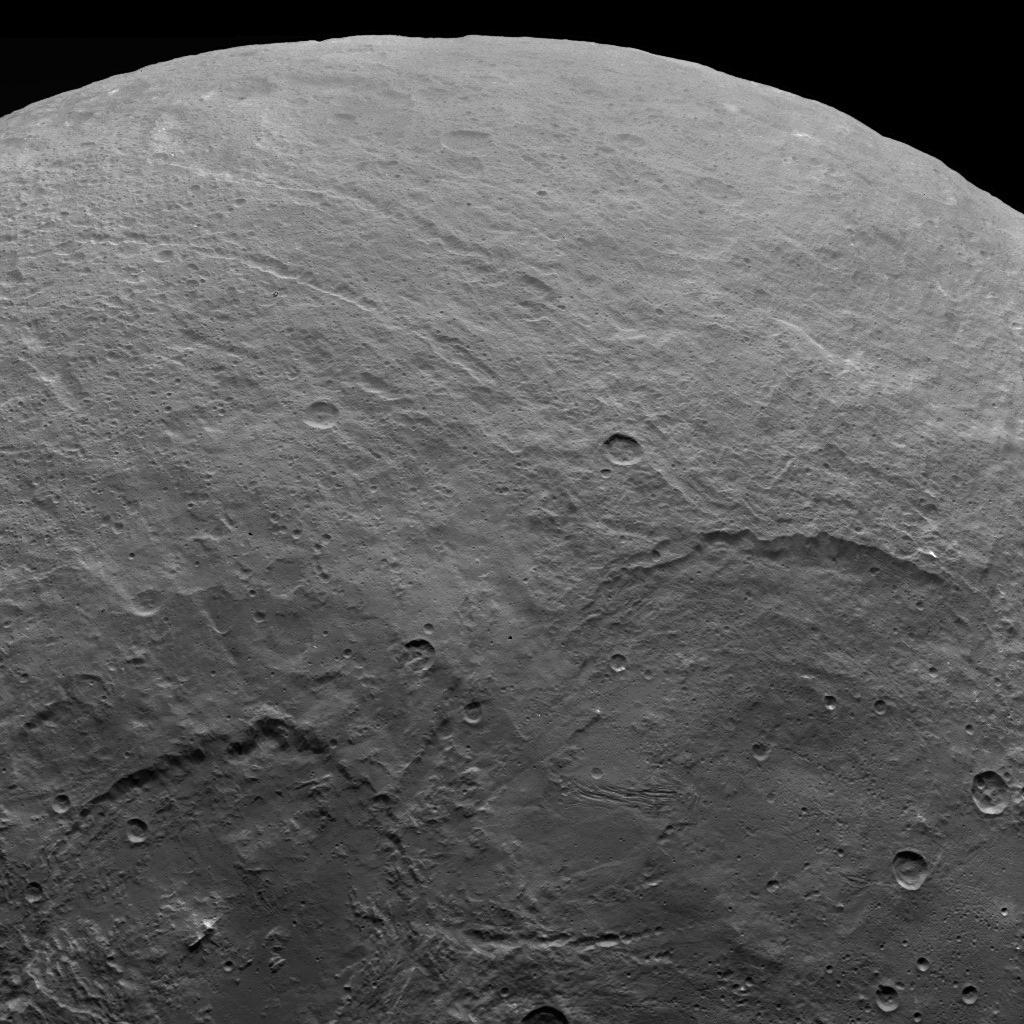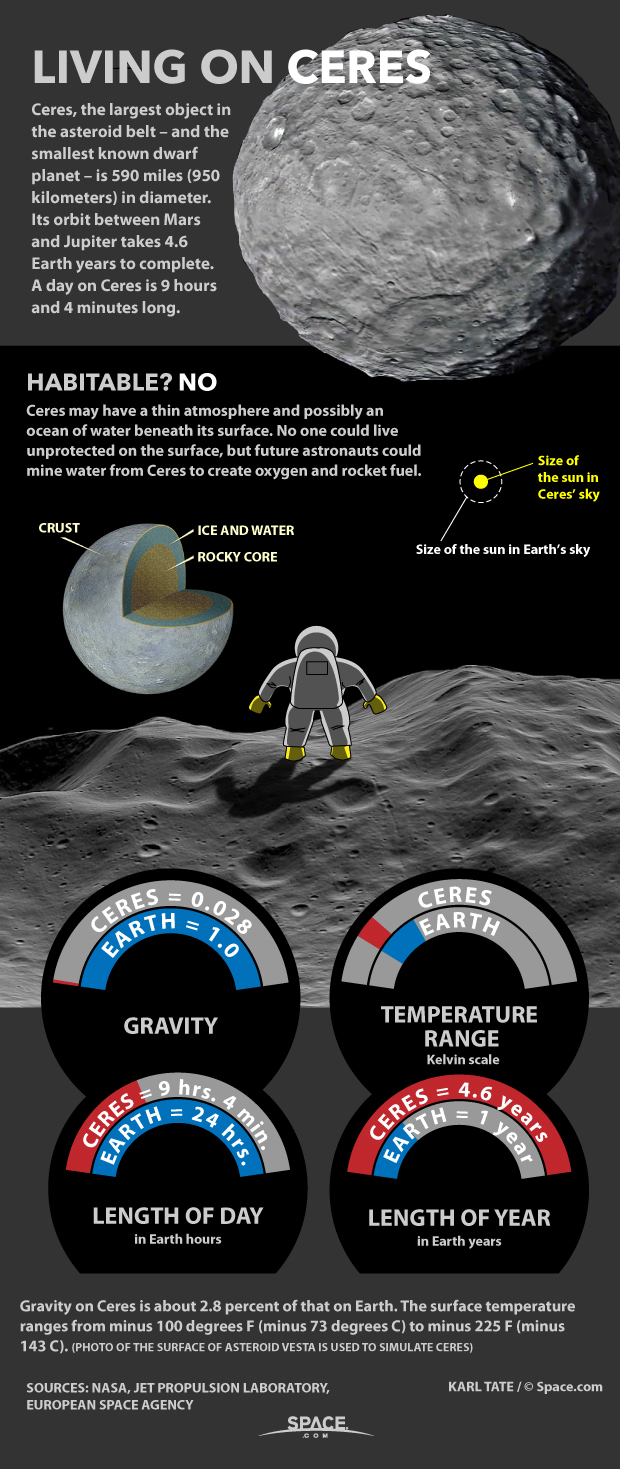Could We Colonize Ceres Like in SyFy's 'The Expanse'?

In the new SyFy channel series "The Expanse," colonists live on a Ceres that is very different from the dwarf planet seen today — but what if NASA were to send a human mission out to Ceres as it is now, without changing the dwarf planet?

In "The Expanse" on SyFy features a hollowed-out asteroid (and dwarf planet) populated by a core group of miners as well as a society of civilians. The asteroid spins, so the colonists all experience gravity. But if an expedition went out today, the explorers would find a totally untamed environment. What challenges would they face?
This is something that in small part is already being explored by the Dawn mission, which has been hanging around Ceres for the better part of 2015. The orbiting probe has just moved to a lower mapping altitude to get a good look at the surface of Ceres, and already some clear differences are showing up compared with another large, rocky body: Earth's moon. [Living on Ceres: What It Would Be Like (Infographic)]
Ceres' surface is an intriguing place: Dawn has seen white spots on Ceres, which are likely salt deposits, and craters with hexagonal shapes, which happen because the gravity is so low that the edges of a crater form along fractures of the surface. And the terrain is rough, meaning it will prove difficult for future rovers and humans to explore, Dawn's investigators said.
Getting there

The first thing a colonist would have to think about is the sheer distance between Earth and Ceres. When Ceres is at its maximum distance from the sun — roughly four Earth-sun distances, known as astronomical units (AU) — a one-way message from the Earth to Ceres takes about 30 minutes to arrive. Even at the dwarf planet's shortest distance from Earth, there's a 15-minute delay. That's compared with about 20 minutes for communications to get to Mars. A phone call for help would take some time for a response.
It would be possible to build habitats on the surface of Ceres even though the surface gravity is about 40 times that of Earth, Dawn principal investigator Christopher Russell told Space.com. But the dwarf planet receives about 10 times less sunlight than Earth.
"You just have to put out 10 times as many solar panels," said Russell, a space physicist at the University of California, Los Angeles. "That's basically what we do on our spacecraft. We have very large solar arrays, much larger than we need to operate at Earth."
Get the Space.com Newsletter
Breaking space news, the latest updates on rocket launches, skywatching events and more!
While it may take some time to set up a habitat, it would be easy for the colonists to heft building materials given everything weighs 40 times less, he pointed out. But there would be other threats to worry about. With no substantial atmosphere protecting colonists from radiation or micrometeroids, any potential habitat would need to be robust enough to protect the people inside from those threats.
Living off the land
There also don't appear to be natural structures that could be used as habitats, unlike on the moon, Dawn scientist David Williams told Space.com. Williams is also a planetary geologist at the University of Arizona.
The moon has lava tubes, and some people have talked about repurposing these structures into habitats. An alternate idea for Ceres — a place bereft of the silicate lavas needed to create such tubes — would be to use inflatable habitats (similar to those in development by Bigelow Aerospace) and then bulldoze rocky material over the habitat to serve as a radiation shield.
Living off the land on Ceres may be more difficult than doing so at the moon, but it's hard to say yet as the dwarf planet is just this year getting its first close-up. Still, any water ice on Ceres seems (so far) to be buried in the dwarf planet's interior, despite the discovery of a definitive signature of water ice in Ceres' atmosphere. The water ice on Earth's moon may be a little closer to the surface, at least at the poles.
"When you think about colonizing planets or asteroids, we often talk of the live-off-the-land approach that was done when our ancestors colonized the American West," Williams said. "We recently saw that in the movie 'The Martian,' where Matt Damon's character uses the soil and water on Mars to grow plants," Williams added. "It's much more difficult to do that on an asteroid, particularly if you don't have access to nutrients in the soil or something like that."
Another potential challenge is the time it would to get out there. Russell said that using the Space Launch System, a next-generation rocket NASA hopes to use for solar system missions, it would take about a year to get to Ceres. Dawn, by contrast, would take roughly six years on a direct route using its lower-power ion engine. (In reality, the probe made a pit stop at the asteroid Vesta and therefore took longer to reach Ceres.)
Episode 6 of the SyFy Channel's 10-episode series "The Expanse" will air tonight (Jan. 12) at 10 p.m. ET (Check local listings).
Follow Elizabeth Howell @howellspace, or Space.com @Spacedotcom. We're also on Facebook and Google+. Original article on Space.com.
Join our Space Forums to keep talking space on the latest missions, night sky and more! And if you have a news tip, correction or comment, let us know at: community@space.com.

Elizabeth Howell (she/her), Ph.D., was a staff writer in the spaceflight channel between 2022 and 2024 specializing in Canadian space news. She was contributing writer for Space.com for 10 years from 2012 to 2024. Elizabeth's reporting includes multiple exclusives with the White House, leading world coverage about a lost-and-found space tomato on the International Space Station, witnessing five human spaceflight launches on two continents, flying parabolic, working inside a spacesuit, and participating in a simulated Mars mission. Her latest book, "Why Am I Taller?" (ECW Press, 2022) is co-written with astronaut Dave Williams.
